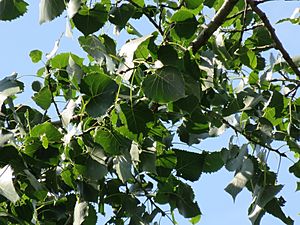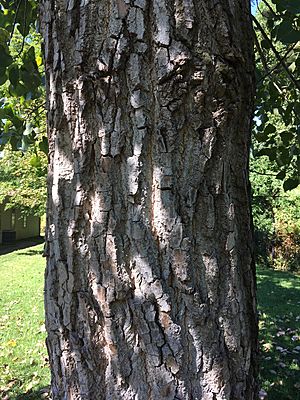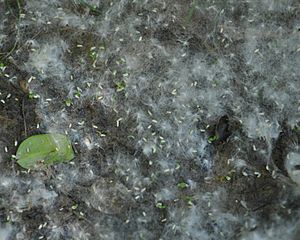Eastern cottonwood facts for kids
Quick facts for kids Eastern cottonwood |
|
|---|---|
 |
|
| Foliage | |
| Conservation status | |
| Scientific classification | |
| Genus: |
Populus
|
| Species: |
deltoides
|
 |
|
| Native range | |
The Populus deltoides, often called the eastern cottonwood or necklace poplar, is a type of poplar tree. It is native to North America. You can find it growing across the eastern, central, and southwestern United States. It also grows in the southern Canadian prairies, the southernmost part of eastern Canada, and northeastern Mexico.
Contents
About the Eastern Cottonwood
The eastern cottonwood is a very large tree. It can grow to be about 20 to 60 meters (65 to 200 feet) tall. Its trunk can reach up to 2.8 meters (9 feet) wide. This makes it one of the biggest hardwood trees in North America.
When the tree is young, its bark is silvery-white and smooth. As it gets older, the bark turns dark gray and has deep cracks. The small branches, called twigs, are grayish-yellow and thick. They have large, triangular scars where leaves used to be. The winter buds are thin, pointed, and yellowish-brown. They are also sticky.
This tree is one of the fastest-growing trees in North America. In areas like the Mississippi River bottoms, it can grow 3 to 4.5 meters (10 to 15 feet) taller each year for a few years. It often grows about 1.5 meters (5 feet) in height and 2.5 centimeters (1 inch) in width every year for 25 years.
The eastern cottonwood is most common in the Midwestern United States. It is not as common in the Northeast. Any trees found there might have been planted by people.
Leaves and Flowers
The leaves of the eastern cottonwood are large and shaped like a triangle. They are about 4 to 10 centimeters (1.5 to 4 inches) long and 4 to 11 centimeters (1.5 to 4.3 inches) wide. The bottom of the leaf is flat. The leaf stem, called a petiole, is flat and about 3 to 12 centimeters (1 to 4.7 inches) long.
The leaves have very rough, curved teeth with small glands at their tips. They are dark green in summer. In the fall, they turn yellow. However, some cottonwoods in dry places lose their leaves early due to drought. This means their fall color might be dull or missing. Because the leaf stem is flat, the leaves shake easily even in a light breeze. This is a good way to identify the tree.
The eastern cottonwood has separate male and female trees. This is called being dioecious. Its flowers, called catkins, grow in early spring. Male catkins are reddish-purple and about 8 to 10 centimeters (3 to 4 inches) long. Female catkins are green and 7 to 13 centimeters (2.7 to 5 inches) long when they are pollinated.
By early summer, the female catkins grow to 15 to 20 centimeters (6 to 8 inches) long. They have many small seed capsules. These capsules are called samaras. They are about 6 to 15 millimeters (0.2 to 0.6 inches) long. When they open, they release many tiny seeds. Each seed is attached to cotton-like strands. One tree can release as many as 40 million seeds in a season!
Types of Eastern Cottonwood
The eastern cottonwood species has different types, called subspecies or varieties. Here are the three main subspecies:
- Populus deltoides subsp. deltoides, known as the eastern cottonwood. You can find it in southeastern Canada (southern Ontario and Quebec) and the eastern United States. It grows as far west as North Dakota and Texas.
- P. d. monilifera is called the plains cottonwood. It grows from south-central Canada (southern Alberta, Saskatchewan, and Manitoba) down to the central United States. It reaches as far south as northern New Mexico and Texas.
- P. d. wislizeni is known as the Rio Grande cottonwood. It grows from southern Colorado south through Texas to northeastern Mexico. This includes parts of Chihuahua and San Luis Potosi. It also grows west into Arizona.
Where Cottonwoods Grow
Eastern cottonwood trees need bare soil and lots of sunlight to grow well. In nature, they often grow near rivers. The mud banks left after floods are perfect for their seeds to sprout. People planting them has also helped them grow in new places away from rivers.
Unlike some related trees, like the quaking aspen, the eastern cottonwood does not spread by sending out new shoots from its roots. However, if you cut down an eastern cottonwood, it will easily grow back from the stump.
The leaves of these trees are a food source for many different types of caterpillars.
How People Use Cottonwood
The wood from the eastern cottonwood is soft, like other Populus trees. It weighs about 450 kilograms per cubic meter (28 pounds per cubic foot). People use it to make things like plywood. It is also used for the inside parts of furniture.
Long ago, during a winter campaign in 1868–69, General Custer fed the bark of these trees to his horses and mules. Also, cowboys would make a special tea from the inner bark. They used it to help with stomach problems.
Oldest and Biggest Cottonwoods
Eastern cottonwoods usually live for 70 to 100 years. But if conditions are perfect, they can live much longer, even 200 to 400 years!
The Balmville Tree, which was cut down in 2015, used to be the oldest eastern cottonwood in the United States.
Here are some of the largest eastern cottonwood trees in the United States:
- The biggest Populus deltoides var. deltoides is in Beatrice, Nebraska. It is about 27 meters (88 feet) tall and 33 meters (108 feet) wide.
- The biggest Populus deltoides var. monilifera is in Ravalli County, Montana. It is about 34 meters (112 feet) tall and 29 meters (94 feet) wide.
- The biggest Populus deltoides var. wislizeni is in Bernalillo County, New Mexico. It is about 26 meters (84 feet) tall and 25 meters (83 feet) wide.
The largest cottonwood tree ever recorded is the Frimley Park tree in Hastings, New Zealand. It is about 42 meters (138 feet) tall, 34 meters (111 feet) wide, and 10.2 meters (33.4 feet) around its trunk. This amazing tree was planted in the 1870s.
State Tree Symbol
The cottonwood tree is sometimes called "the pioneer of the prairie." Because of this, the state of Kansas chose the cottonwood as its official state tree in 1937. It also became the state tree of Wyoming in 1947. Since 1972, it has been the state tree of Nebraska.
See also
 In Spanish: Álamo negro de Norteam%C3%A9rica para niños
In Spanish: Álamo negro de Norteam%C3%A9rica para niños




